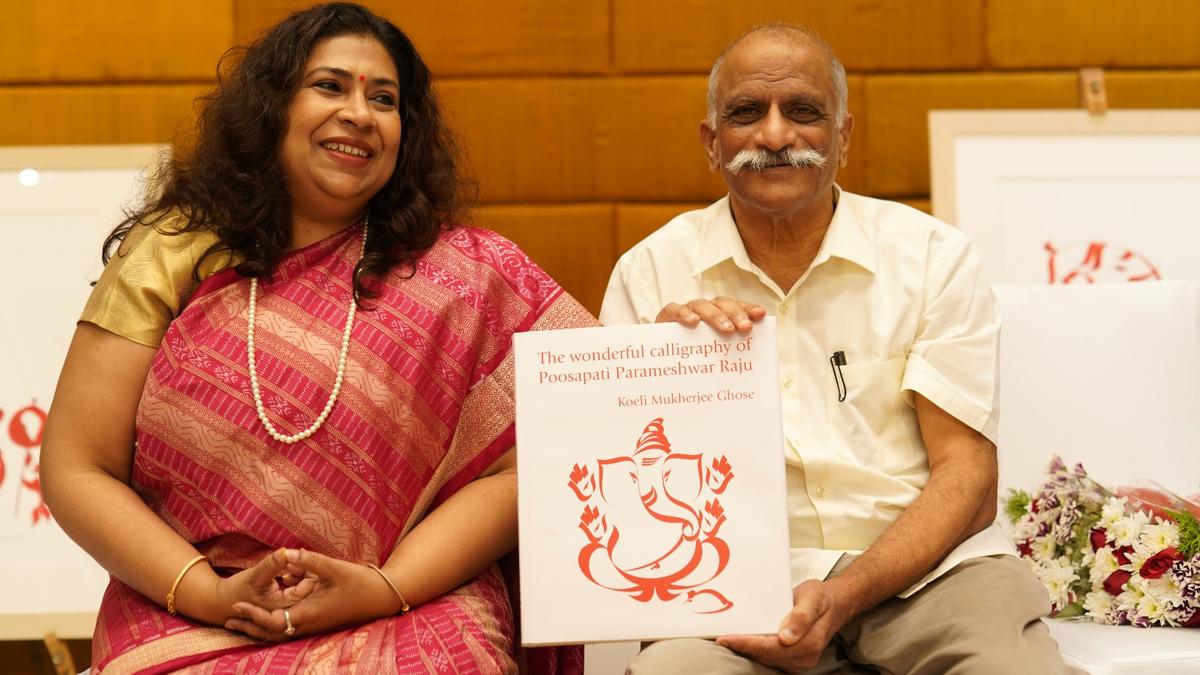
The Wonderful Calligraphy: Koeli Mukherjee chronicles the artistry of Parameshwar Raju
The Hindu
Discover the enchanting world of calligraphy by artist Parameshwar Raju through Koeli Mukherjee Ghose's detailed account in a new book.
Last weekend, while crowds carried Ganesha idols to Hyderabad’s Hussain Sagar for immersion, art enthusiasts immersed themselves in the enchanting world of calligraphy crafted by artist Parameshwar Raju.
At a gathering at Hotel Marigold for the launch of The Wonderful Calligraphy of Poosapati Parameshwar Raju, the spotlight was on the artist himself alongside author and art historian Koeli Mukherjee Ghose.
The 425-page tome, weighing four kilograms, features 457 images of Parameshwar’s original works and Koeli’s detailed account of his 40-year artistic journey. The book transcends being a mere biography; it offers a deep insight into his art and life that is possible only through the perspective of a fellow artist and a storyteller of Koeli’s calibre.
Koeli recounted an episode at the event, which is also the book’s opening chapter. During a train journey, Parameshwar sat cross-legged in his seat and conjured magic with his calligraphy pen. He effortlessly executed perfect thin-thick-thin strokes with a rhythmic flow, and was wholly absorbed in his craft throughout the journey, oblivious to the curious onlookers and fellow passengers.
Drawing inspiration from the iconography of traditional symbols, myths, and ancient motifs, Parameshwar masterfully infuses a modern sensibility into his art with just a few bold strokes. As you turn the book’s pages, images of Ganesha, Krishna, Anantashayana Vishnu, Mahishasura Mardhini, Anjaneya, Vanaras, and more, captivate you with their striking red minimalism. His work weaves elements of sthalapurana (historical, religious significance of the place), iconography, and epic narratives, creating a unique visual language that bridges the past and the present. For Parameshwar, mastering pothis — a demanding form of writing that requires meticulous control of space and proportion — unlocked a whole new dimension of calligraphy.
Born in Andhra Pradesh, Parameshwar began his artistic journey of calligraphy with the Devanagari script. However, as his work evolved, he delved deeper into his cultural heritage, creating rich pictorial narratives reflecting his roots. Beginning with the sacred symbol of Aum, Parameshwar gradually infused his calligraphy with the visual essence of deities, integrating elements like vahanas (vehicles) and ayudhas (weapons). Over the past two decades, he has masterfully brought Puranic lore to life through his remarkable art. His unique style has made him a distinguished artist in Hyderabad and earned him global acclaim.
Koeli notes in the book how Parameshwar embraced the inherent constraints of calligraphy with pride in his artistic expression. What might have been a limitation for a figurative artist, he elevated to a celebrated art form, granting it a unique place in the creative landscape. Working masterfully within the boundaries of calligraphy, he adhered to the precise thin-thick-thin strokes of his pen, consistently using the colour red, symbolising Shakti and creating stunning narratives. His art spans various subjects, from Puranic lore and childhood memories to contemporary icons, beautifully showcased in the book.













